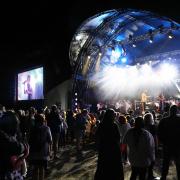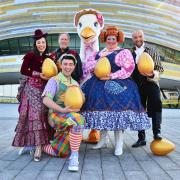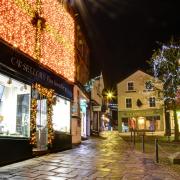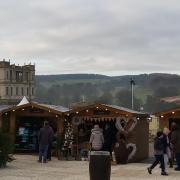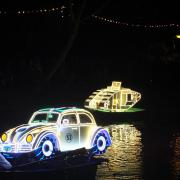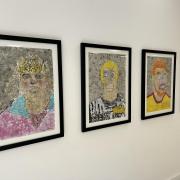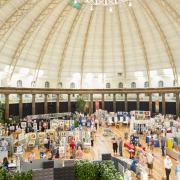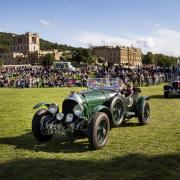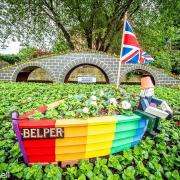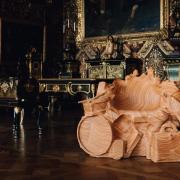The fascinating story behind the success of leading local entrepreneur Stuart Garner who earlier this year unveiled his newly renovated home

If someone declares they’re ‘living the dream’, it invariably sounds a bit hollow. But as I lounge in the vast palatial splendour of a stately home with Stuart Garner, its wealthy, successful owner – a self-made man who has earned his riches revitalising a famous British motorcycle marque that he loved as a child – his declaration is as resounding as the roar of a Commando 961.
If you’re a biker, you’ll know that a Commando is made by Norton. Founded in Birmingham back in 1898, Norton became one of the world’s most renowned motorcycle names. It still is, thanks to Stuart: in 2008, he bought the Norton brand, effectively rescuing it from an uncertain future. If you’re not a biker but a car user, you’ll appreciate this comparison: Stuart saving Norton is the equivalent of David Wilkins saving Aston Martin.
It’s a comparison Stuart should appreciate in that it also emphasises the Britishness of the brand. So where better to house the Norton industry than here in the heart of England? Even more romantically, Stuart has become lord of the manor through acquiring Donington Hall, only a walk away from the new Norton production facility at Hastings House which, even more appropriately, sits alongside the Donington race track, the very place where young Stuart cultivated his passion for motorcycles in general, Norton in particular.
‘As a youngster in the late 1980s,’ recalls Stuart, ‘I would go to Donington Park with my father and watch the British Championships. As the Norton JPS bikes came round the track, all the Union Jacks were waved. The Japanese had dominated the sport for so long so it was exhilarating to see a British bike coming through.’

At that time, Stuart’s father, mother and all of his teachers must have wondered whether the lad would amount to much. Raised in Barrow on Trent and educated at Chellaston, the 16-year-old Stuart left school with no qualifications.
As Stuart remembers: ‘My parents were disgusted because they’d done all right for themselves and my elder brother was at university. I think mum and dad had given up on me; I was the black sheep of the family. School gave me no focus; academia left me cold. I preferred bird-nesting and playing snooker and, as soon as I got a motorcycle, I was scrambling down at the gravel pits. I didn’t want to be in the classroom – I just wanted to do “boy’s stuff”.’
Doing boy’s stuff also blemished Stuart’s first job opportunity: after three years as a gamekeeper at Foremarke Hall, he was sacked – ‘the hours were very long and exacting and I was too much into girls, motorcycles and beer’ – but the boy started to grow when he dated a particular girl. ‘I was 18 and my girlfriend’s dad was a bit Victorian. He said, “You’re not taking my daughter out if you haven’t got a job. You can start in my warehouse on Monday”.’
One could say young Stuart had been given a rocket in the best way possible: the warehouse was part of a fireworks business, and this was to fire a fledgling entrepreneur, as he recalls: ‘Suddenly I went from £16 a week to £70 a week. I went from what I thought was my darkest hour – because I wept when I lost my job as a gamekeeper – through another door of opportunity. I realise now that I was on my way to bigger, better things.’

Stuart’s old school mates then who spurred him on further: ‘They were finishing A Levels and starting apprenticeships and real jobs. I saw them buying cars and getting on the property ladder. I was shifting boxes and couldn’t even afford to have a drink with them, yet I knew I was every bit as good and could do better.’
Stuart bettered himself by saving as much as he could and, appropriately, used funds earned from repairing a damaged motorcycle to pay for his first house and to release some capital – for his own fireworks enterprise. Suddenly, Stuart was a 19-year-old running a business. By his early 20s, the company was valued at £1 million. It was clear that Stuart had an instinct for business.
‘Yes, I was presentable and could talk to people,’ says Stuart, ‘and I found that if I was buying something, I could usually get it a bit cheaper than it was being sold for. Also, when it came to opportunity, I was able to see past what the next man can see. This is something no business school can teach you.’
Stuart is still presentable and loquacious. He’s also full of charm, confidence and conviviality, a refreshing antithesis to the stern besuited corporate mogul, but he’s no hairy biker either. Instead, he cuts an affable Everyman image in faded jeans, casual jacket and slight stubble, the kind of man you could happily sit round a bar with, though once you’ve both exhausted your enthusiasm about girls, motorcycles and beer, he could then impress you with stories of setting up a 3,500-acre game reserve near Botswana to breed animals for safari parks, breaking a world land speed record at Bonneville Salt Flats and – let’s deal with the really big story first – singlehandedly reclaiming and reviving the revered Norton name.

As Stuart’s business grew into Fireworks International – now one of Britain’s leading pyrotechnics firms – he became a partner in Spondon Engineering which regularly made frames and parts for Norton bikes. By chance one day, Stuart saw the Norton logo being applied to a bike bound for the British National Motorcycle Museum and asked if the use of the logo had been authorised. Blank looks all round... So, Stuart searched – and found – the owner of the Norton trade name, an American investment banker called Ollie Curme. Authorisation was duly granted. A few years later, in 2008, Ollie Curme telephoned Stuart with an offer.
He takes up the story:‘Ollie’s company suffered in the Lehman’s crash of 2008 so he was selling the Norton brand and asked if I was interested. The call was on a Monday and the offer was alive until the Friday, by which time he would be selling it to a clothing consortium. Ollie said, “If you agree to make bikes, we’ll shake on the deal.” He said that because he was a biker he didn’t want to see it become just a clothing brand. So I jumped on a plane that night and was in his office the following morning. I did my due diligence on Tuesday, Wednesday and Thursday and signed on the Friday.’
Stuart had few doubts about buying even though he had invested only in the Norton marque. There were no bikes, let alone a factory – just the property rights and CDs containing engineering drawings. So why was it, as he later described it, ‘a once in five lifetimes’ opportunity’?
‘First of all, Norton has a great sense of history – it was THE first British motorcycle firm. It won the first TT race in 1907 and it’s finished first 94 times. It helped the War effort, supplying 10,000 bikes to the military. It’s had incredible success. OK, it’s had failures – it’s been bankrupt a few times – but it’s never been bland and I feel there’s a certain passion and excitement about Norton that doesn’t apply to other brands. Get ten bikers together and I think nine would pick Norton as their number one choice.’

Stuart rose to the biggest challenge of his career and by 2010 Norton was riding again. It’s taken a supreme effort with Stuart working 100 hours a week – ‘I still do’ he states – and putting in particular hours to ensure his bikes are, as far as possible, British-made.
As a glittering exemplar of the entrepreneurial spirit, Stuart’s take on his success with Norton is refreshingly simple: ‘Making a motorcycle business earn money didn’t seem to be a very complex problem and I think the simplicity of my approach made it successful. My design team know that making a great motorbike is complicated but when I had a meeting with those guys, my approach was “just press the ‘make’ button, boys.” I gave them the problem of making the bikes and, by not getting bogged down by the detail, I was able to concentrate on the rest of the business – dealing with finances, brand value, market position, distribution and dealer network – in order to sell at a higher price than it cost to make, and make a profit. Business is simple, really: buy the product at £1, sell it for £2 and make sure you operate for less than £1.’
However, when I ask Stuart if knowing Norton’s chequered history had made him nervous, he reveals how much mettle and acumen turning round a failing brand has taken: ‘I took a long, hard walk through the automotive graveyard where you’ll find TVR, BSA, Triumph and, yes, Norton, so that I could acknowledge all the causes of death and come out learning from other peoples’ mistakes.’
Bringing back Norton from the dead is maybe not as miraculous as it sounds considering Stuart had reawakened a giant of the automotive world. ‘Key to success has been letting the brand be the brand. We’ve not tried to change the course of the brand or deny its history. We’ve revelled in that history.’

There is a definite glint in Stuart’s eye when I ask him about his first bike – ‘a 50cc chicken chaser’ – and his knowledge and love of the biking world has been a key factor in his success.
‘The manliness of motorcycles – the engineering, the speed, the leathers – got to me from an early age, and because I was pretty broke a motorcycle was my first form of transport – and you don’t forget that. Also, if you go biking enough times, you will go out in the sunshine but you may come back in the rain. All this makes you a level person. It’s rare to see an arrogant motorcyclist. If you’re a biker, it’s odds-on you have pushed your bike home at some point, maybe soaked to the skin, or sat on the side of the road thumbing a lift. When those things happen to you, it makes you a more rounded, grounded person.’
Stuart is also aware that the person who buys into Norton is a certain type: ‘When you buy a Honda, it’s all about numbers. How many miles in between services? How much does it cost? How fast does it go? But when you buy a Norton, it’s all about brand, lifestyle, your enjoyment and a tangible experience. We’re authentic.’
Part of the reason Stuart went to the Bonneville Salt Flats in 2009 and wrote himself into the history books, setting the land speed record for a rotary powered motorcycle – on a Norton, of course – at 173 mph, was to help give the business a face: ‘Seeing me as the owner brings more affinity from the customer base – and from the industry – than when the business is a faceless corporate.’
What has also boosted Norton is its coterie of celebrity customers who include Bruce Springsteen, Orlando Bloom and Top Gear’s Richard Hammond. Interestingly, Stuart perceives that one of the reasons known names go motorbiking is because they can put on a crash helmet and be hidden. ‘That’s why David Beckham likes riding a bike,’ says Stuart. ‘He gets his life back.’
Stuart still lives for his regular spin on his bike, ‘I go out on the lanes round here in this beautiful rolling countryside. For me, motorcycling is about the freedom. Some guys like to rev it up and blast some eardrums in the city. I like to take it easy, sweeping round the rural bends and taking in what’s around me.’
Stuart is now more embedded in that rolling countryside as the incumbent of the 220-year-old Grade II listed Donington Hall. He bought the Hall at the same time as he moved his operation from Donington Park to Hastings House – a mere stroll from the house – where the 45,000 square feet of modern building can accommodate his growing workforce, estimated to be around 150 by this time next year.
‘I kept looking over the fence, quite literally, at Donington Hall,’ says Stuart. ‘I’ve wanted one of these since I was about ten. I suppose it goes back to my gamekeeping days at Foremarke. But it wasn’t just about the house; we wanted a prestigious address to match the brand and the product. Donington Hall conjures up a uniquely British way of showing style, strength and quality which are all great attributes of the Norton brand. I wanted this to be a showcase for foreign dealers and visiting clients are certainly impressed.’
At the same time, though, the house has become another part of Stuart’s empire with Donington Hall being promoted as a multi-purpose venue. As Stuart showed me around I could sense straightaway an idyllic wedding location. Rebecca Whitehouse, Events and Venue Manager of Top Marques UK, which is running the Donington Hall operation, tells me that there are many special qualities to the venue: ‘Essentially the strength of this Hall is that we have stunning architecture and rich history and we can promote it to wedding couples as a blank canvas. It’s adaptable and versatile – you can use any of the internal spaces or just use the extensive grounds for a marquee. Couples who have viewed the Hall have been awestruck by its size, grandeur and elegance.’
The internal spaces include a vast, grandiose entrance hall with a high, sweeping staircase, a beautiful bedroom suite and even a chapel which Rebecca is hoping can be used for wedding services. The sitting and drawing rooms are huge and stately. One of them could be called The British Room as it houses the largest Union Jack I have ever seen, draped over a massive table, with the walls displaying Stuart’s collection of originals by George Turner, ‘Derbyshire’s John Constable’. Turner hailed from Barrow on Trent which takes us back to Stuart’s first home.
I wondered if Stuart was waking up each morning in his new home and pinching himself at his good fortune. He nods. ‘If I had written down my ten key points of an address, this would have ticked all ten,’ says Stuart. ‘When you’re house hunting, it’s rare to tick all ten boxes. It’s a complete dream to live and work in a place like this.’
Donington Hall
Visible from the far side of the race track at Donington, but otherwise secluded, the great Gothick pile of Donington Hall was built by the 1st Marquess of Hastings in 1795 to the designs of William Wilkins, architect of the National Gallery. The dissolute life of the 4th and last Marquess brought about the ruin of the estate and after his death in 1868 it was sold and became the property of the Gillies Shields family who owned it until the 1970s. Historical highlights included providing a home for members of the Bourbon family during the French Revolution, and housing some 500 German officers – prisoners of war – in the First World War. It was used as a refugee camp following the Second World War but it seemed inevitable that it would suffer the same fate as so many great houses. Then in 1976 it was bought by British Midland International who put into action an impressive specialist restoration project. Perished stonework, collapsed ceilings, dry rot and lead stripped from the roof were just some of the problems they overcame but they retained as many of the Hall’s original features as possible. It became their headquarters for the following 30 years in 1982.






